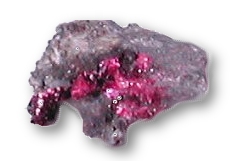

| Types of Rock | | | Properties | | | Volcanoes | | | Articles |
Erythrite

| Chemical Composition: Co3(AsO4)2.8H2O | |
| Group: arsenate |
Hardness: 1.5-2.5 |
| Colours: colorless, violet-red, light pink, purple-red | |
| Streak: pinkish red |
Density: 3-3.1 |
| Luster: pearly |
Cleavage: perfect |
Erythrite, hydrous cobalt arsenate, is a secondary (weathered) portion of cobalt ore deposits. It has a very bright red-purple color, and for this reason miners sometimes call it a "Cobalt Bloom". The name Erythrite comes from Greek erythros - meaning red. It was named as such by F. S. Beudant in 1382.
Erythrite usually forms very small crystals which create a coating or small aggregates rather than distinct large crystals. Large crystal specimens of Erythrite are rare but they do exist.
Per se, Erithrite is not an economically important mineral, but it is very strongly associated both with cobalt and silver ores and it is a good indicator of veins of cobalt-bearing ore. Erythrite creates prismatic needle-like crystals which can be found most notably in Schneeberg, Germany, Bou Azzer in Morocco and Cobolt, Ontario in Canada.
Both the colour and luster of Erythrite are light and temperature sensitive and deteriorate quite rapidly, which is another reason why this mineral has not been exploited in jewellery.
Where both cobalt and nickel ores are found, one can also find Annabergite - the appropriately named "Nickel Bloom". Annabergite is bright green, and like Erythrite, is also useful as an indicator of valuable ore.
It is more interesting that both Erythrite and Annabergite are isostrucural; which means that they both have an identical structure but differ in their chemical composition. In the case of Annabergite, the cobalt has been replaced by nickel (Ni3(AsO4)2-8(H2O) ).
 |
| Rocks in Focus |
© Biscuit Software 2016